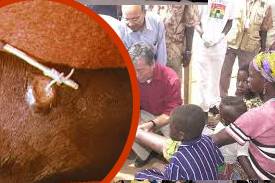Breaking News: Ghana Nears Victory Over Guinea Worm Disease – A Major Public Health Milestone!
Introduction: A Giant Leap in Public Health
Ghana is making remarkable progress in the fight against Guinea worm disease, bringing the country closer to complete eradication. This achievement marks a significant milestone in global health, as Guinea worm disease has been one of the most persistent parasitic infections in Africa. Through rigorous public health campaigns, improved water sanitation, and community education, Ghana has managed to reduce the number of cases to near zero.
With the world shifting its focus toward eliminating preventable diseases, Ghana’s success story serves as an inspiration. In this article, we explore the journey toward eradicating Guinea worm disease, the challenges faced, and the impact of this triumph on Ghana’s health sector.
What is Guinea Worm Disease?
A Deadly Yet Preventable Parasitic Infection
Guinea worm disease, also known as Dracunculiasis, is a parasitic infection caused by drinking water contaminated with larvae of the Guinea worm (Dracunculus medinensis). Once ingested, these larvae mature inside the human body over the course of a year before emerging through painful sores on the skin. This process is excruciating and can leave victims immobilized for weeks or even months.
How Guinea Worm Spreads
The disease primarily spreads through contaminated water sources. Here’s how it happens:
Infected individuals enter water bodies, releasing thousands of Guinea worm larvae.
The larvae are then ingested by water fleas, which thrive in stagnant water sources such as ponds and lakes.
When humans consume this contaminated water, they become infected, continuing the cycle.
Ghana’s Road to Eradication: How Did We Get Here?
The Role of Public Health Campaigns
Ghana’s fight against Guinea worm disease has been a collective effort involving the Ministry of Health, the World Health Organization (WHO), and non-governmental organizations (NGOs) such as The Carter Center. Some of the key strategies implemented include:
Education & Awareness: Local communities were educated on the dangers of drinking unfiltered water and encouraged to adopt preventive measures.
Improved Water Sanitation: The government worked tirelessly to provide clean drinking water through boreholes and protected wells.
Case Containment & Surveillance: Every suspected case was monitored closely, and infected individuals were isolated to prevent further contamination.
Distribution of Water Filters: Households in affected regions received water filters to prevent infection.
Major Milestones in Ghana’s Eradication Journey
2000s: Over 4,000 cases were reported annually, highlighting the urgent need for intervention.
2010: Cases dropped significantly due to mass education and water treatment initiatives.
2015: Ghana was close to reaching zero cases, with only a handful of infections reported in remote areas.
2024: The country is on the brink of being officially declared Guinea worm-free!
Challenges Faced in Eradicating Guinea Worm Disease
1. Remote and Hard-to-Reach Areas
Many affected regions in Ghana are rural communities with limited access to healthcare. Health workers had to travel great distances, often on foot, to reach infected individuals.
2. Resistance to Change
Traditional beliefs and a lack of trust in modern medicine sometimes hindered progress. Some communities were reluctant to stop using contaminated water sources, believing in ancestral ties to these locations.
3. Climate Change & Water Scarcity
As clean water sources became scarcer, some communities resorted to using unsafe water, increasing the risk of infection. This made it crucial to ensure a steady supply of safe drinking water.
4. The COVID-19 Pandemic
The pandemic diverted resources and attention away from Guinea worm eradication, but health officials remained resilient, continuing to push for elimination.
The Impact of Eradicating Guinea Worm Disease
Economic Benefits
Increased Workforce Productivity: With fewer people suffering from painful infections, more individuals can contribute to Ghana’s workforce.
Cost Savings on Healthcare: Less money is spent on treating the disease, allowing resources to be redirected to other pressing health concerns.
Health Benefits
Improved Quality of Life: People no longer suffer from the painful and debilitating effects of the disease.
Better Access to Clean Water: The fight against Guinea worm disease has led to improved water infrastructure, benefiting communities in multiple ways.
What’s Next? Sustaining Ghana’s Guinea Worm-Free Status
1. Continued Water Sanitation Efforts
Although the disease is nearly eradicated, maintaining access to clean drinking water remains crucial to prevent any resurgence.
2. Vigilant Surveillance
Health officials must remain vigilant in monitoring potential cases and responding promptly to prevent new outbreaks.
3. Community Involvement
Public participation is key. Community members must continue practicing safe water habits and report any suspected cases immediately.
4. Global Collaboration
Ghana’s success can serve as a model for other African nations still struggling with Guinea worm disease. Sharing strategies and best practices can help eliminate the disease worldwide.
Conclusion: A Historic Win for Ghana!
Ghana’s near-eradication of Guinea worm disease is a monumental public health victory. It showcases the power of education, government intervention, and community participation in fighting preventable diseases. While challenges remain, the country’s progress serves as hope and inspiration for nations still battling the disease.
With Ghana standing on the verge of being declared Guinea worm-free, it’s a testament to what can be achieved when people come together for the greater good. This milestone not only improves public health but also enhances economic productivity and quality of life for all Ghanaians.
Let’s celebrate this success and continue advocating for clean water and disease prevention to ensure a healthier future for generations to come!
What Do You Think?
Do you believe other African countries can follow Ghana’s example? Share your thoughts in the comments below!
💡 Don’t forget to share this article to spread awareness!



